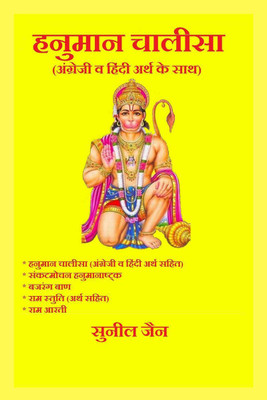Hanuman chalisa with english and hindi meaning / Óż╣Óż©ÓźüÓż«ÓżŠÓż© ÓżÜÓżŠÓż▓ÓźĆÓżĖÓżŠ - ÓżģÓżéÓżŚÓźŹÓż░ÓźćÓż£ÓźĆ ÓżĄ Óż╣Óż┐ÓżéÓż”ÓźĆ ÓżģÓż░ÓźŹÓżź ÓżĢÓźć ÓżĖÓżŠÓżź(Hindi, Paperback, Sunil Jain)
Quick Overview
Product Price Comparison
1. shri Hanuman chalisa with images, awadhi and english pronunciation, hindi & english translation 2. shri hanuman aarti 3. shri sankat mochan hanumanastak 4. shri bajrang baan 5. shri ram stuti with meaning 6. shri ram aarti ABOUT HANUMAN CHALISA : The Hanuman Chalisa (Devanagari: Óż╣Óż©ÓźüÓż«ÓżŠÓż© ÓżÜÓżŠÓż▓ÓźĆÓżĖÓżŠ; Hindi pronunciation: [╔”╔Ön╩Ŗma╦Én t╩āa╦Éli╦Ésa╦É]; literally Forty chaupais on Hanuman) is a Hindu devotional hymn (stotra) addressed to Hanuman. It is traditionally believed to have been authored by 16th-century poet Tulsidas in the Awadhi language, and is his best known text apart from the Ramcharitmanas. The word "ch─ül─½s─ü" is derived from "ch─ül─½s", which means the number forty in Hindi, as the Hanuman Chalisa has 40 verses (excluding the couplets at the beginning and at the end). Hanuman is a vanara (a monkey-like humanoid deity), a devotee of Rama, and one of the central characters in the Sanskrit epic Ramayana. Folk tales increasingly eulogise the powers of Hanuman, and he is considered by many to be an avatar of the god Shiva. The qualities of Hanuman ŌĆō his strength, courage, wisdom, celibacy, devotion to Rama and the many names by which he was known ŌĆō are detailed in the Hanuman Chalisa. There are more temples devoted to Hanuman than any other deity in India, and recitation or chanting of the Hanuman Chalisa is a common religious practice.

